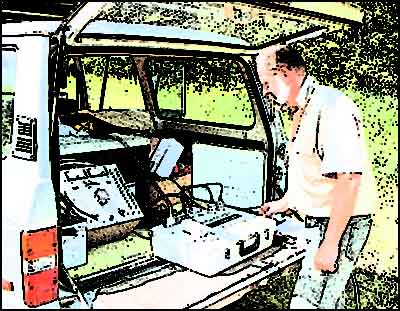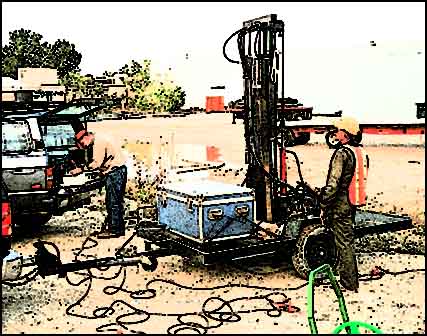View
of the 9048 Seismograph (bottom center) and
Roll Switch (left center)
seismic
source. Geophones are also selected according to the needs of the survey: higher-frequency
phones for high-resolution work, lower-frequency for deeper targets. Our Bison
Instruments 9048 seismograph offers 48-channel recording capability, with internal
data storage to enhance field productivity. The 9048 floating-point system
is one of the best engineering seismographs available today, with recording
specifications better than many petroleum exploration systems.
Seismic
field acquisition involves three basic elements:
- a source of acoustic energy
- seismic receivers, or geophones
- a seismograph, or recorder, to collect and store
the data
The
arrangement of source and geophones depends on the nature of the survey.
Typically, the geophones are placed along a line at equal intervals (1 to 5
feet for high-resolution, 10 to 20 feet for deeper work). For seismic
reflection, the relative source and geophone positions are usually held constant
with the entire 48-geophone array being moved along with the shot. (The logistical
difficulties of this are eased by using a "roll switch", which
Seismic
Refraction: Midspread Setup with Seismograph, EWG III, and Geophones in view
The
choice of seismic source depends on the needs of the particular survey. For
deeper work, a powerful source, such as one of our Elastic Wave Generators
(EWG), trailer-mounted accelerated weight drops, would be used. Shallow,
high-resolution work, not requiring the power of an EWG, can be done by striking
a steel plate with a sledgehammer or using the "Betsy"
selects 48 geophones from an overall
spread of 96.) Refraction work requires shots at
opposite ends of the spread, with additional shot locations depending on the
particular needs of the job.

email:
consultants@geosphereinc.com
124 north auburn road auburn, mi 48611 tel: (989) 662-6149
fax: (989) 662-7701
copyright ©1990-2007 geosphere inc




![]()

